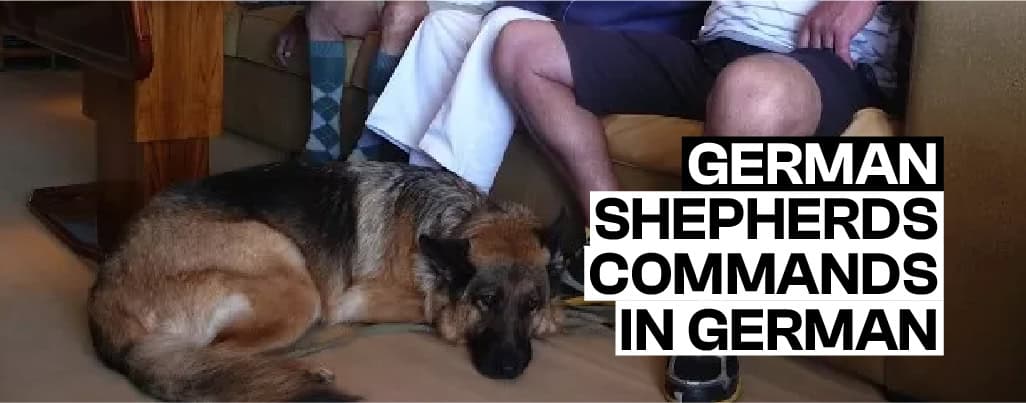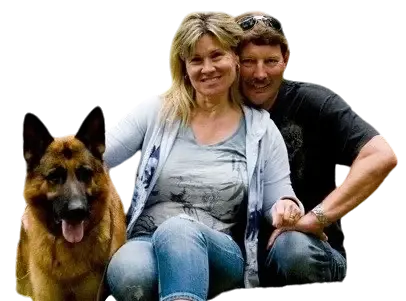
German Shepherd Dog Commands in German with Pronunciation
Have you ever wondered why German Shepherds respond so well to German commands?
Many dogs, like German Shepherds, Dobermans, Dachshunds, Boxers, Schnauzers, and Rottweilers, breed from Germany. Many of them are trained there and understand German commands. Moreover, it’s polite to make the effort to speak the native tongue. Furthermore, the commands in German for German Shepherds sound authoritative compared to English, increasing the chances of the dog following your commands.
So, don’t risk confusion and equip yourself with a vital list of German Shepherd dog commands for a smoother training journey.
SUMMARY
- The commands are divided into Basic, Intermediate, and Advanced levels for effective training.
- Key German commands for basic obedience include “Sit” (Sitz), “Stay” (Bleib), and “Come” (Komm).
- Explore commands for intermediate and advanced training, including specialized commands used for advanced tasks like protection work and scent detection.
- Gain insight into specific German commands used for training police and military German Shepherds and how they are applied in professional contexts.
German Shepherd Commands List
It’s best to begin with basics and work through advanced dog commands. We have divided the German Shepherd commands into three categories.
- Basic Obedience Commands
- Intermediate Commands
- Advanced Commands
It allows you to learn them quickly and effectively train your German Shepherd dog. Remember, every dog learns at a different speed. So, don’t get frustrated if your dog doesn’t understand you right away.
CALL Michael and Jeannette Today!
Train with the Best – Elite German Shepherd Schutzhund/IPO Training in Los Angeles!

Basic Obedience Commands
The basic commands are focused on making the German Shepherd obedient and protecting it from dangerous situations when outside. So, not only do you have to start with basic dog commands in German, but it is also best to start with basics with your German Shepherd.
Here are the basic German Shepherd command words.
| English Command | German Dog Commands Pronunciation | Response |
| Sit | Sitz [Zits] | German Shepherd sits on the ground. In other words, put their bottom on the ground. |
| Stay | Bleib [Blyb] | The dog stays in the position until you go to them |
| Down | Platz [Plahts] | The dog drops to their belly and stops moving forward |
| Come | Komm [Kohm] | German Shepherd moves forward to you |
| Stop | Halt [Hahlt] | The dog stops its movement and stands still |
| No | Nein [Nine] | German Shepherd immediately stops what they’re doing (don’t yell this at your German Shepherd, but use a firm voice) |
| Yes | Ja [Yah] | Used when your GSD performs a command or behavior correctly |
| Wait | Warte [ˈvaʁtə] | It tells the dog that you want them to wait for you |
| Slow | Langsam [ˈlaŋzam] | Tells them to slow their speed |
| Good Dog | Braver Hund [ˈbʁaːfɐ ˈhʊnt] | A general dog German Shepherd dog command for praising |
Intermediate Commands
The German dog commands focused on the activities of your German Shepherd. Commands in German for German Shepherds are instrumental in making them easier to control in parks, on walks, and during mealtime.
| English Command | German Command & Pronunciation | Response |
| Crawl | Krabbeln [Krah-beln] | The dog drops to its belly and crouches low to move forward |
| Stand | Steh [Shtay] | German Shepherd stands on all four paws |
| Spin | Dreh dich [Dreh deekh] | Tell them to turn either left or right in a circle |
| Drop It | Lass es fallen [Lahs es fahlen] | Command them to release an item from the mouth |
| Leave It | Lass es liegen [Lahs es leegen] | Stops them from picking up or following an object they are interested in |
| Go In | Geh rein [Geh rine] | The German Shepherd goes inside a room |
| Go Out | Geh raus [Geh ra-ous] | The German Shepherd goes outside a room |
| Speak | Bell [Bel] | The dog barks for you |
| Quiet | Ruhe [Roo-heh] | German Shepherd stops barking |
| Paw | Pfote [Pfoh-teh] | It tells them to give their paw for a paw-shake |
| Watch Me | Schau mich an [Schow meesh ahn] | Commands them to keep eye contact with you |
| Off | Runter [Roon-ter] | Tells them to get off the object they are on (couch, chair) |
| Go Eat | Geh essen [Geh es-sen] | Gives German Shepherd the permission to go eat (usually given after a wait request) |
| Heel | Fuß [Foos] | Your German Shepherd comes to your left side |
| Fetch | Bringen [Bring-en] | The dog gets an item and brings it back to you |
Advanced German Shepherd Commands
Advanced German Shepherd commands go beyond the basics; they need a high level of training and understanding from your dog. The German dog training commands are for specialized tasks or to enhance the dog’s training even in your house and responsiveness. Some advanced commands are effective in Schutzhund / IPO, Police, and Military training. They are great mental stimulants and have different names depending on the situation and the handler’s preferences.
Advanced Commands are usually for
- Off-leash control
- Released to go to a specific spot
- When retracing specific objects
- Protection and agitation work
- Emergency Recall
- Advanced trick commands
- Scent detection
The advanced commands need patience, consistency, and training from a professional dog trainer. The advanced command significantly improves their ability to handle difficult situations and remain calm.
CALL Michael and Jeannette Today!
Your Loyal German Shepherd is Just a Call Away – Purebred and Ready for Your Family!

What are the German Police Dog Commands?
Police and military dogs are typically trained using German dog commands. Before hitting the streets and battlefields, the dog and the handler undergo training for a set of German commands.
Here is the German dog commands list for effective police dog training to ensure clear communication between the handler and the K-9 partner.
| English Command | German Command & Pronunciation | What It Means |
| Retrieve | Bring [bʁɪŋk] | Bring the Item to the handler |
| Here/Come | Hier (hee-r) | Come when called |
| Heel | Fuss (foos) | Walk calmly by your side |
| Alert | Anzeigen [ˈanˌʦaɪ̯ɡŋ̍ | Commands them to signal when they find something |
| Let Go | Aus (ow-ss) | Release the held object |
| Go Out | Voraus (for-ows) | Move forward |
| Track | Such (zook) | Track or follow a scent |
| Guard | Pass Auf | Be vigilant or guard |
| Bite | Packen/Fass | Bite on command |
| Jump | Hopp (hup) | Jump on command |
| Speak | Gib Laut | Bark on command |
| Go Ahead | Geh Raus | Move forward or go ahead |
| Go Inside | Geh Rein | Enter a building or go inside |
| Stand | Steh (Sh-tay) | Stand still |
| Narcotics/Dope | Rauschgift | Indication of narcotics or drugs |
| Find Narcotics | Such Rauschgift | Search for narcotics or drugs |
| Building/Blind Search | Voran (for-ahn) | Search a building or area |
| Kennel | Zwinger | Go to your kennel |
| What is going on | Was ist los? (vas ist low-s) | Assess the situation |
| Good (praise) | So ist Brav | Praise for good behavior |
| Don’t do that | Lass das sein | Cease the action or behavior |
| OK | In Ordnung | Acknowledgment of Compliance |
| Eat Food | Nimm Futter | Eat the provided food |
| Article Search | Such Verloren | Search for lost articles or objects |
| Fast | Schnell (sch-nell) | Move quickly or speed up |
FAQs
Do German Shepherds really prefer German Commands?
They don’t necessarily prefer German or English; it depends on how well you train them. One of the reasons for using German commands is they are short, snappy, authoritative, and full of attention-grabbing sounds that your dog can easily pick up.
What’s the German Shepherd command for attack?
The command for attack is “Fass”. The word means it’s time to take hold and get to business.
Conclusion
A comprehensive German Shepherd commands list is the passport to success in the world of dog training. It creates a clear and efficient line of communication between you and your loyal German Shepherd. Whether you are starting with a German Shepherd puppy or honing the skills of your adult German Shepherd, the list of commands will make training easier.
Feel free to share your experiences, ask any questions, or add any tips and tricks that have worked for you in training your German Shepherd.






